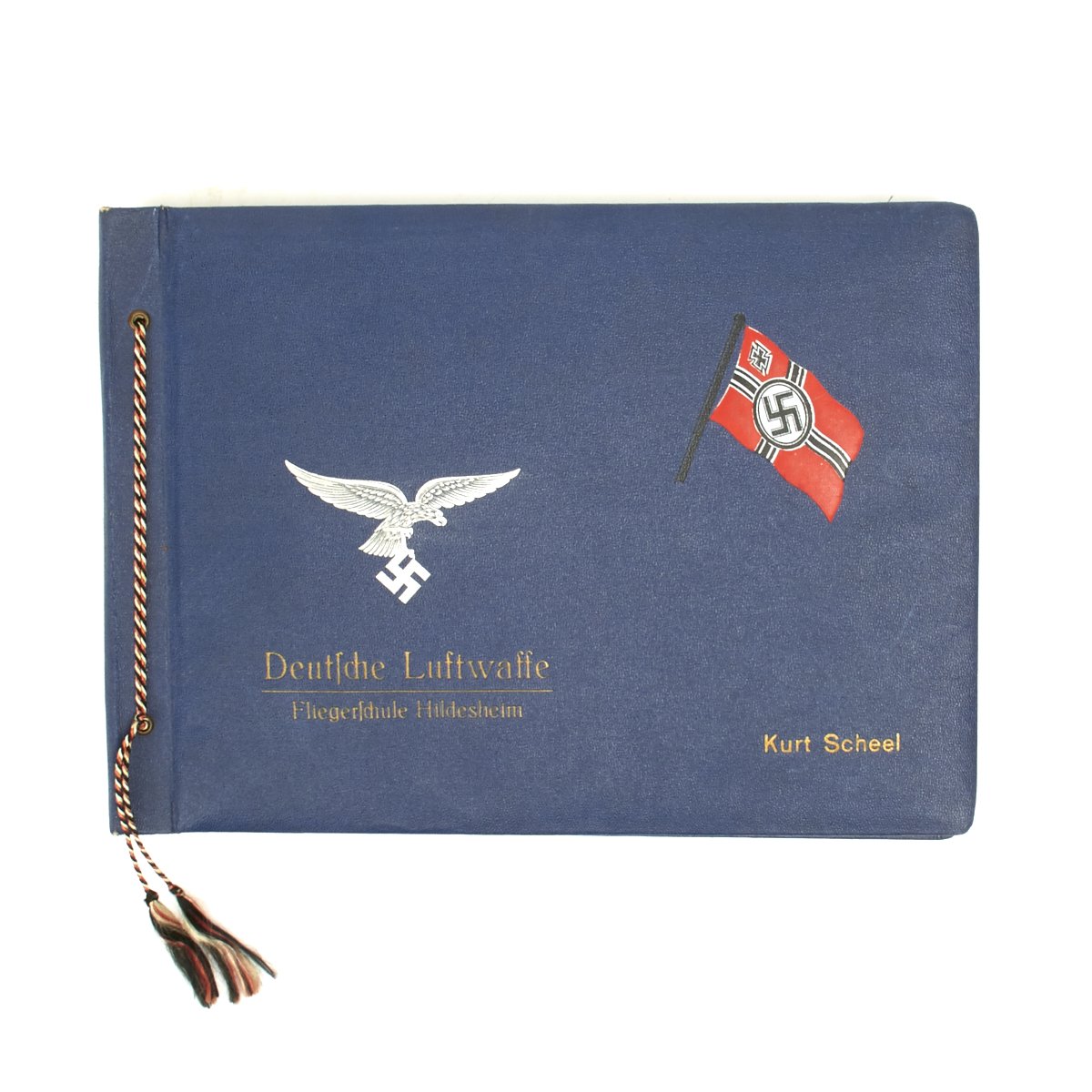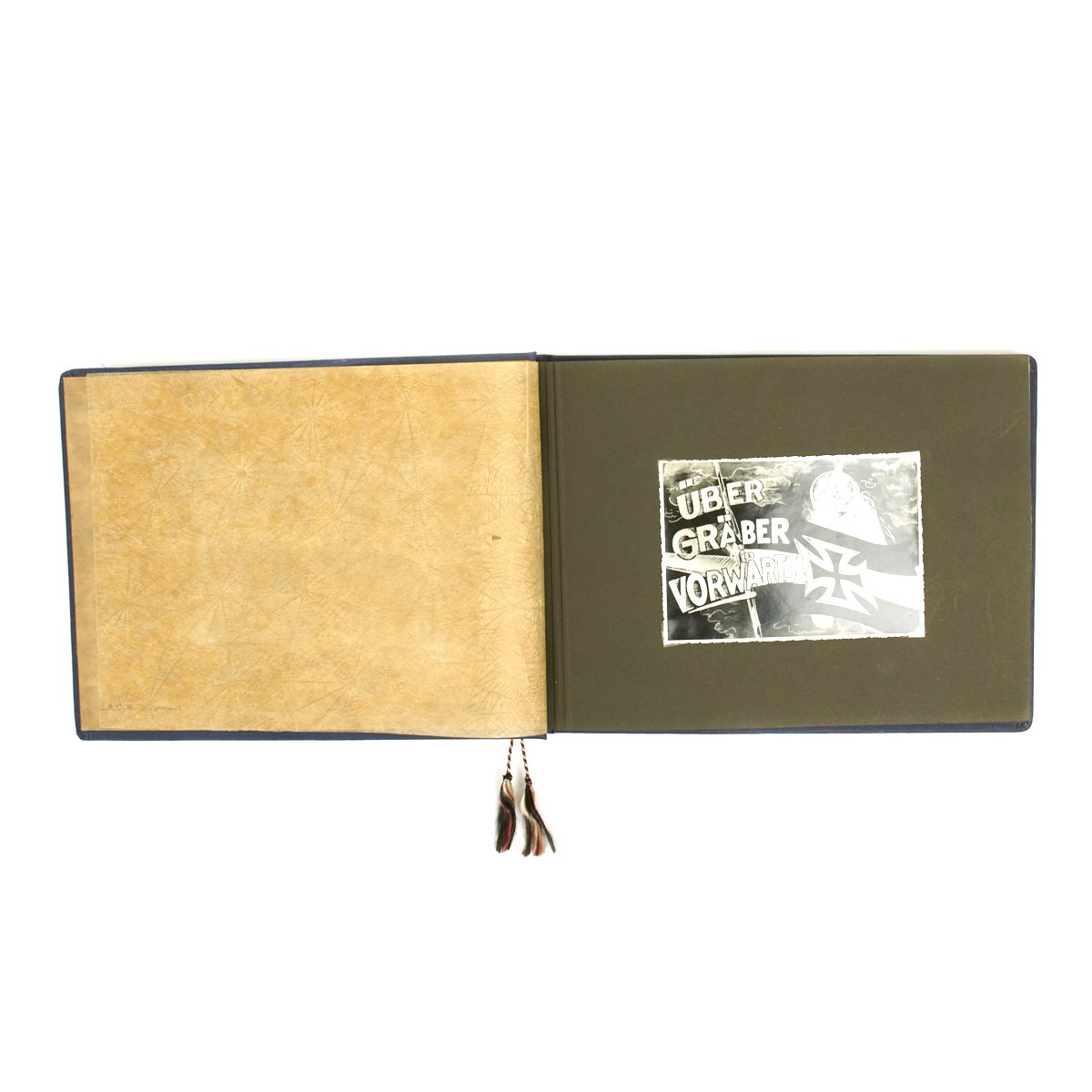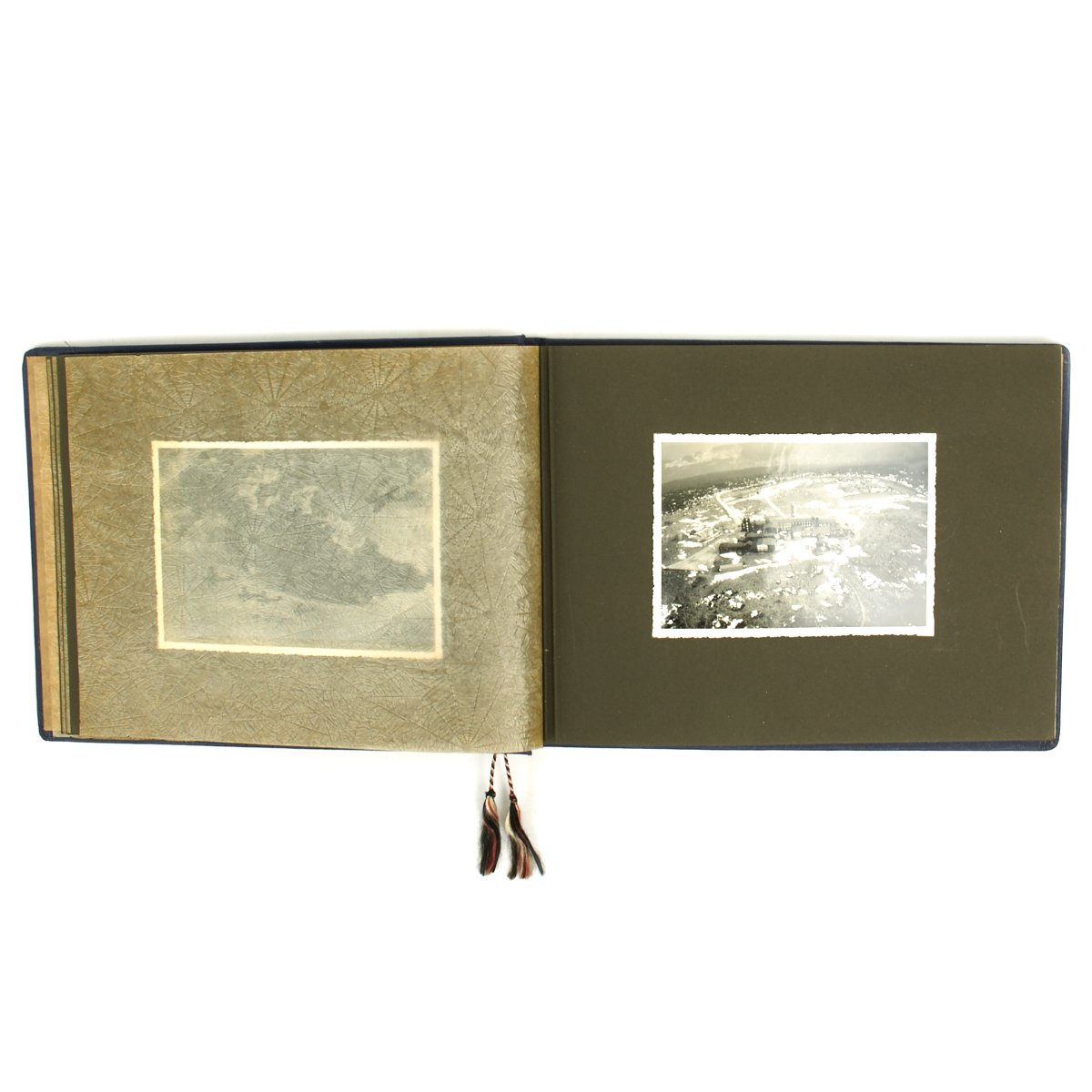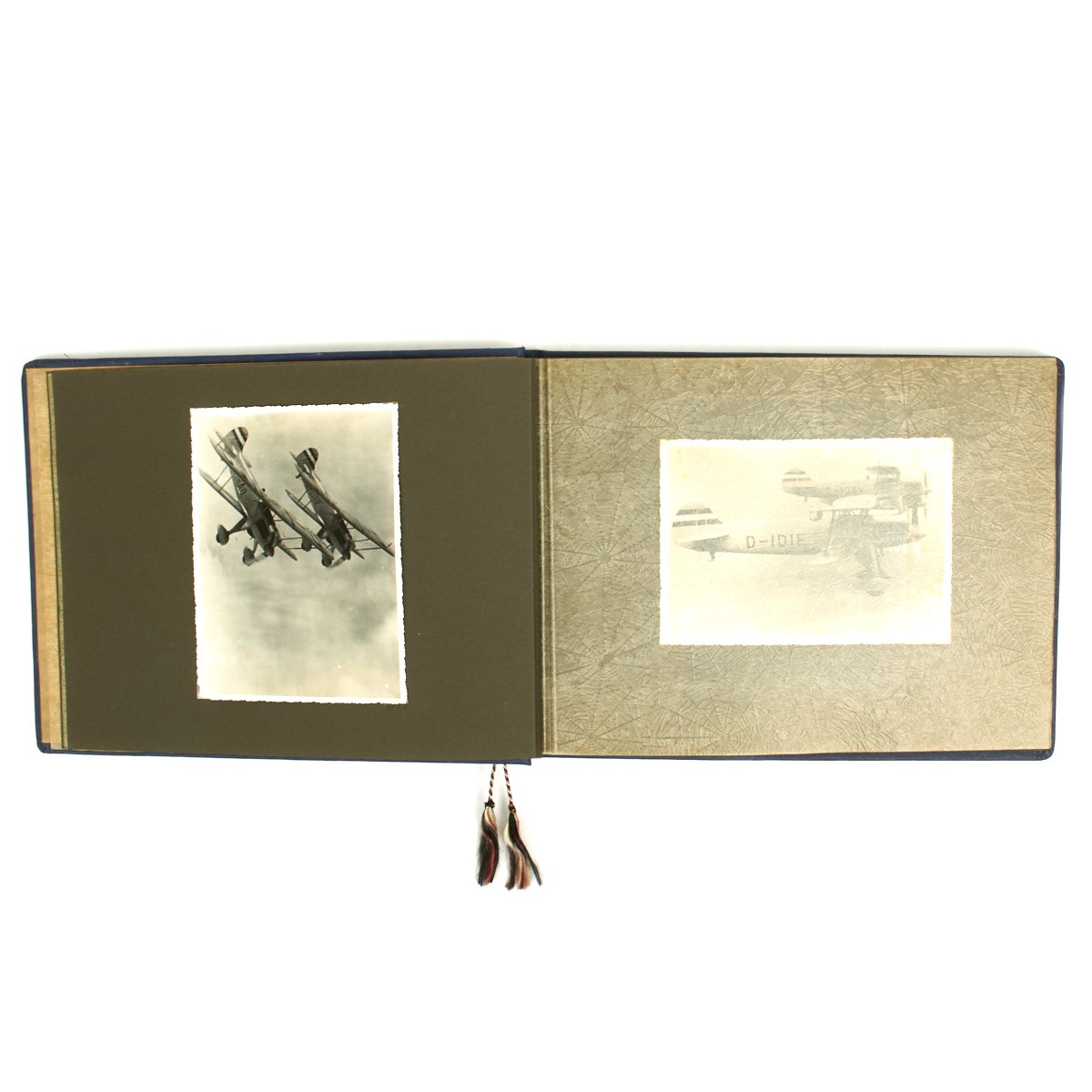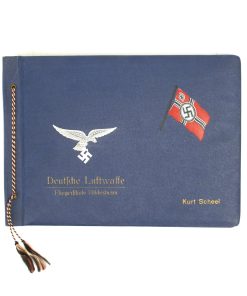Original German WWII Luftwaffe Named Photo Album – Kurt Scheel Original Items
$ 495,00 $ 148,50
Original Item: One-of-a-kind. A wonderful, very clean carefully assembled collection of professional photographs and personal snapshots from WW2. It is the album of Kurt Scheel, who was stationed the Fliegerschule Hildescheim (Flyers School Hildescheim) before and in the early part of World War Two. There are more than 40 photographs which are about evenly divided between soldiers, officers and planes.
The album cover is very attractive and in excellent condition. Featuring a Luftwaffe blue leatherette with a finely detailed silver Luftwaffe eagle, a full color battle flag, and the gold embossed writing that reads: Deutsche Luftwaffe Fliegerschule Hildescheim along with Kurt Scheel.
The album features numerous photographs of German aircraft including many biplanes which we used for training. Also, featured are troops, officers such as Oberstleutnant Reinecke, Christmas celebrations, official funeral, Luftwaffe officers, barrack, parades, and some wartime postcards.
A total of over forty high quality photographs fill this album, making it a treasure-trove of images taken from the viewpoint of a patriotic German airman. Historical records like this album have become priceless time capsules that provide an incomparable level of insight into the individual experience of the Second World War, now that over seventy years have passed.
History of the Fliegerschule Hildescheim:
On October 1, 1934 the aviation school Hildesheim was set up in the eastern part of the barracks. This school also had various types of aircraft for their training purposes, from the Messerschmitt Bf 108 to the Dornier Do 17-E 1. In the work of this unit, some discoveries which were exciting for history research fell. With the help of stereoscopic recordings, the position of the Kaiserpfalz at Werla / Oker, which was not yet found, could be found in March 1937. Even later, after the occupation of Greece, the corrupted port facilities of Corinth were rediscovered there during practice flights there in 1940.
A part of the flying school was the teaching command for large-area flying. These specialists, with their Heinkel He 111, Junkers Ju 52 and Ju 88, produced precision large-area images, from which maps for the war on all fronts emerged. Among other things, the Cyrenaika in Lybia, the Balkan and many sections on the eastern front had been captured. The Lehrkdo has been reclassified as an independent aerial image 1 on 15.10.43. In the late summer of 1944, the outsourcing of aircraft and equipment to the Wrisbergholzen evacuation site, about 18 kilometers south, took place for safety reasons. There the staff arrived in a youth hostel, the airplanes were parked at the edge of the forest. An interesting incident on the edge: 14 days after the occupation of Wrisbergholzen by the US Army landed an He 111 of the relay from Norway in ignorance of the situation on the square. The crew was hidden by local residents.
A further important phase for the Fliegerhorst Hildesheim began on 2 November 1939. At this time the “Sturmabteilung Koch” occupied the barracks. The soldiers belonged to the strictly shielded new parachute group. This was trained here for the imminent Western campaign, the Hildesheim squad was to conquer the Belgian obstacle level Emael. For training, a field with the outlines of the fort was staked out in a nearby field, whereupon they practiced the landing. Equipped were the parachute hunters with DFS 230-load sailers, which were towed by Ju 52. The Koch section has been extended to the Parachute Regiment 1. All the measures took place under strict secrecy. The load sailers were supplied with furniture carts and mounted in hangars at the northern edge of the flight field. On May 9th, 1940, the regiment relocated to the harbors on the western border of Germany. On the next day the attack on the fortress was followed in the early morning.
The company “Merkur” also started from Hildesheim. This involved the conquest of the Mediterranean island of Crete. In this case, the attack began on 20 May 1941, after heavy losses, the goal was achieved.
A number of different flying units were found during the Second World War on Hildesheim Airborne Horseman. Among them were the IVth group of the combat squad 51 “Edelweiss”, who converted from Ju 88 to Me 410 and retrained here, as well as the 2nd / Destruction squad 26 to defend the Allied bomber fleets. At the end of the war there were also hunting associations on the square, but they were hardly used because of the lack of fuel. Even in the heavy bomb attacks on the city in March 1945, the hunters were condemned to inactivity.
February and March 1945, the 1st Group of the KG 200 was located in Hildesheim. This association was equipped with prey machines, including three Boing B-17 Flying Fortress and a Consolidated B-24 Liberator of the US Air Force. They should carry out special orders under the utmost secrecy, including the removal of “Wehrwolfen” with murder orders behind the enemy lines. The machines were set to march to 6.445 to move to Fürstenfeldbruck.
On April 7th, the US Army eventually occupied the city, and the Second World War was thus also ended for the Fliegerhorst.
Fast Shipping with Professional Packaging
Thanks to our longstanding association with UPS FedEx DHL, and other major international carriers, we are able to provide a range of shipping options. Our warehouse staff is expertly trained and will wrap your products according to our exact and precise specifications. Prior to shipping, your goods will be thoroughly examined and securely secured. We ship to thousands clients each day across multiple countries. This shows how we're dedicated to be the largest retailer on the internet. Warehouses and distribution centres can be located throughout Europe as well as the USA.
Note: Orders with more than one item will be assigned a processing date depending on the item.
Before shipping before shipping, we'll conduct a thorough inspection of the items you have ordered. Today, the majority of orders will be delivered within 48 hours. The delivery time will be between 3-7 days.
Returns
The stock is dynamic and we cannot completely manage it because multiple stakeholders are involved, including our factory and warehouse. So the actual stock may alter at any time. It's possible that you may not receive your order once the order has been made.
Our policy is valid for a period of 30 days. If you don't receive the product within 30 days, we are not able to issue a refund or an exchange.
You can only return an item if it is unused and in the same state as the day you received it. You must have the item in its original packaging.
Related products
Uncategorized
Uncategorized
Uncategorized
Australian WWII Owen MK1 Machine Carbine SMG Custom Fabricated Replica with Sling Original Items
Uncategorized
Band of Brothers ORIGINAL GERMAN WWII Le. F.H. 18 10.5cm ARTILLERY PIECE Original Items
Uncategorized
Uncategorized
Uncategorized
Uncategorized
Uncategorized
Uncategorized
Angolan Rebel 1970s era 60mm Inert Display Mortar from Angolan Civil War Original Items
Uncategorized
Armored Burgonet Helmet & Polearm from Scottish Castle Leith Hall Circa 1700 Original Items
Uncategorized
Uncategorized
Uncategorized
Uncategorized
Uncategorized
Uncategorized
Uncategorized
Uncategorized
